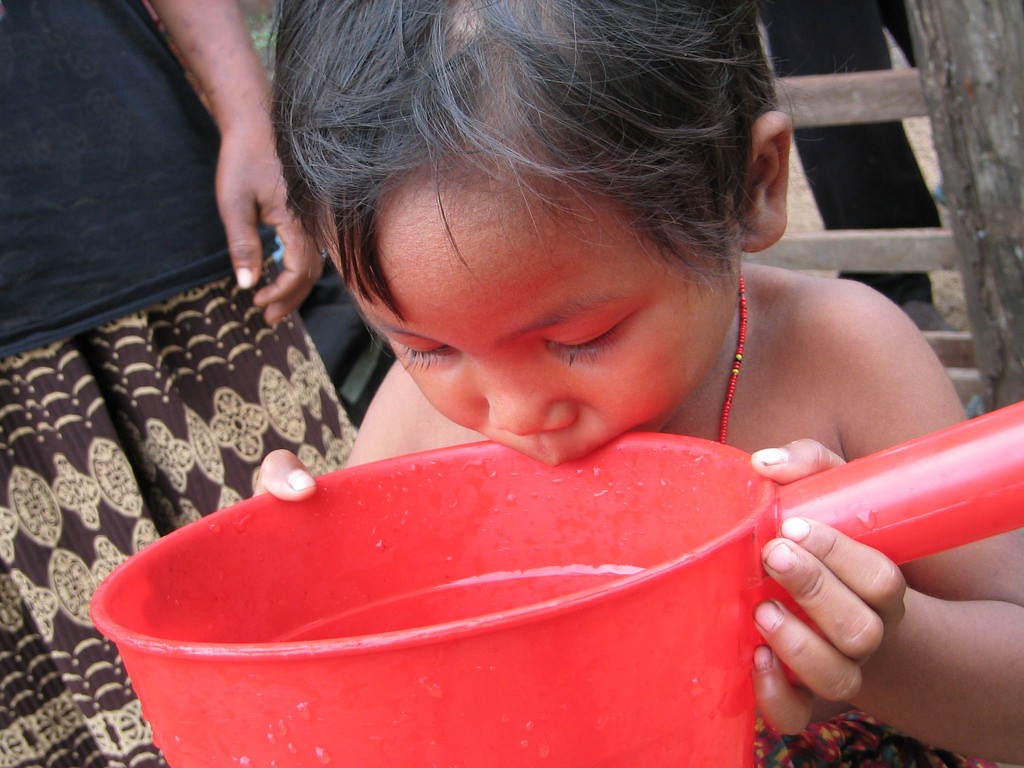
កុមារផឹកទឹកស្អាត នៅប្រទេសកម្ពុជា។ រូបភាព ថតដោត សេស៊ីលា ស្នាយឌឺ, ១២ កក្កដា ២០០៣។ ក្រោមអាជ្ញាប័ណ្ណ CC BY-NC-ND 2.0
ការបំពុលទឹក អាចត្រូវបានគេឱ្យនិយមន័យច្រើនយ៉ាងផ្សេងៗពីគ្នា។ ជាទូទៅ ការបំពុលទឹក គឺជាការធ្វើឱ្យកង្វក់ដល់ទឹក នៅពេលដែលសារធាតុបំពុលនានាបានហូរចូលទៅក្នុងប្រភពទឹកដោយមិនបានឆ្លងកាត់ការធ្វើប្រព្រឹត្តកម្ម (ដកយកសារធាតុបំពុលចេញ)។ ការបំពុលទឹកភាគច្រើន គឺបណ្តាលមកពីសំណល់ពីរោងចក្រឧស្សាហកម្ម កសិកម្ម និងតាមផ្ទះ ដែលផ្តល់ផលប៉ះពាល់យ៉ាងខ្លាំងដល់សុខភាពមនុស្ស និងសត្វ ក៏ដូចជាគុណភាពបរិស្ថាននៃប្រភពទឹកទាំងមូល។
នៅប្រទេសកម្ពុជា លទ្ធភាពទទួលបានទឹកស្អាត និងមានសុវត្ថិភាព នៅតែជាបញ្ហាប្រឈមនៅឡើយ ជាពិសេសសម្រាប់គ្រួសារនៅតាមទីជនបទ ពីព្រោះការផ្តល់សេវា និងហេដ្ឋារចនាសម្ព័ន្ធទឹកនានា នៅមានកម្រិតនៅឡើយ សម្រាប់តំបន់នៅក្រៅពីទីក្រុងធំៗ។
បញ្ហាប្រឈមនៃលទ្ធភាពទទួលបានទឹកស្អាត
អង្គការ UNICEF បានរកឃើញថា ប្រជាជនកម្ពុជាចំនួន ៦.៣ លាននាក់ ក្នុងចំណោម ១៤.៩ លាននាក់ មិនទាន់មានលទ្ធភាពទទួលបានទឹកស្អាតប្រើប្រាស់នៅឡើយទេ។1 នៅអំឡុងពេលនៃទិវាទឹកពិភពលោកឆ្នាំ២០១៤ អង្គការ UNICEF នៅកម្ពុជា បានជំរុញឱ្យរដ្ឋាភិបាលដោយផ្តោតជាសំខាន់ពីការផ្គត់ផ្គង់ទឹកស្អាតនៅទីជនបទ។ អង្គការនេះក៏បានបញ្ជាក់ផងដែរថា មូលហេតុចម្បងដែលប្រជាជនកម្ពុជារាប់លាននាក់ មិនមានលទ្ធភាពគ្រប់គ្រាន់ក្នុងការទទួលបានទឹកស្អាតប្រើប្រាស់ គឺបណ្តាលមកពីរដ្ឋាភិបាលបានដាក់ការផ្គត់ផ្គង់ទឹកស្អាតនៅតំបន់អភិវឌ្ឍន៍ជាអាទិភាព ច្រើនជាងនៅទីជនបទ។2
ការបំពុលដោយសារធាតុអាសេនិច ត្រូវបានរកឃើញនៅក្នុងទឹកផឹករបស់កម្ពុជាក្នុងកំឡុងពេលនៃការសិក្សាវាយតម្លៃលើគុណភាពទឹកផឹកនៅកម្ពុជា ដែលត្រូវបានធ្វើឡើងរួមគ្នាដោយក្រសួងអភិវឌ្ឍន៍ជនបទ និងក្រសួងឧស្សាហកម្ម រ៉ែ និងថាមពល នៅរវាង ឆ្នាំ ១៩៩៩ និង ឆ្នាំ២០០០។3 ដើម្បីដោះស្រាយបញ្ហានេះ ក្រសួងឧស្សាហកម្ម រ៉ែ និងថាមពលបានបង្កើតជាស្តង់ដាគុណភាពទឹកផឹក របស់កម្ពុជាមួយនៅក្នុងឆ្នាំ ២០០៤។4 ជាឧទាហរណ៍ ទឹកផឹកមិនគួរមានផ្ទុកសារធាតុអាសេនិចលើសពី ០.០៥ មីលីក្រាមក្នុងមួយលីត្រនោះទេ។5
សារធាតុអាសេនិច ជាធម្មតាអាចត្រូវបានរកឃើញនៅក្នុងទឹកក្រោមដី និងតំបន់អាងទន្លេមេគង្គ។ ខេត្តកណ្តាល ព្រៃវែង កំពង់ចាម កំពង់ឆ្នាំង កំពង់ធំ និងក្រចេះ ជាបណ្តាខេត្តដែលត្រូវបានរកឃើញថាមានកម្រិតកំហាប់អាសេនិចខ្ពស់បំផុតនៅកម្ពុជា។ ក្នុងចំណោមខេត្តទាំងនេះ ខេត្តកណ្តាល គឺជាខេត្តដែលមានការបំពុលអាសេនិចខ្ពស់ជាងគេបង្អស់។6 នៅឆ្នាំ២០១៤ កាសែត ភ្នំពេញប៉ុស្តិ៍ បានរាយការណ៍ថា នៅក្នុងខេត្តកណ្តាល ៣៥% នៃអណ្តូងយកទៅធ្វើសំណាកចំនួនជាង១៥,០០០ ត្រូវបានរកឃើញថាមានផ្ទុកសារធាតុអាសេនិចខ្ពស់ជាងកម្រិតថ្នាក់ជាតិ ០.០៥ មីលីក្រាមក្នុងមួយលីត្រ ហើយអណ្តូងប្រហែល ៥៤%មានផ្ទុកអាសេនិចលើសពីកម្រិតស្តង់ដារបស់អង្គការសុខភាពពិភពលោក ០.០១ មីលីក្រាមក្នុងមួយលីត្រ។7
ទឹក ពិតជាមានសារៈសំខាន់ខ្លាំងណាស់ក្នុងការរក្សាមនុស្ស និងបរិស្ថានឱ្យមានសុខភាពល្អ ទោះដោយផ្ទាល់ ឬដោយប្រយោលក្តី។ ការបំពុលដោយអាសេនិច អាចនឹងធ្វើឱ្យប្រជាជនកម្ពុជារាប់លាននាក់ ប្រឈមនឹងគ្រោះថ្នាក់ ប្រសិនបើគ្មានសកម្មភាពណាមួយត្រូវបានអនុវត្ត។
នៅក្នុងសេចក្តីសង្ខេបមួយរបស់អង្គការ UNICEF បានរកឃើញថា ផលប៉ះពាល់នៃសារធាតុអាសេនិចដែលបានបង្ករឱ្យកើតជំងឺដង្កាត់ផ្សេងៗ ត្រូវបានចងក្រងទុកប្រមាណជាង ៥០០ឯកសារ ហើយមានចំនួនអ្នកស្លាប់ និងពិការអវៈយវៈជាច្រើនទៀត។8
ច្បាប់ និងបទប្បញ្ញត្តិ
អនុក្រឹត្យស្តីពីការត្រួតពិនិត្យការបំពុលទឹក ត្រូវបានបង្កើតឡើងនៅក្នុងឆ្នាំ ១៩៩៩។ នៅក្នុងអនុក្រឹត្យនេះចែងថា ក្រសួងបរិស្ថាន មានតួនាទី និងទំនួលខុសត្រូវក្នុងការដឹកនាំ ត្រួតពិនិត្យ និងរាយការណ៍អំពីសកម្មភាពនានាដែលអាចបណ្តាលឱ្យមានការបំពុលជាយថាហេតុ។ ក្រុមហ៊ុន ឬអង្គភាពនានាដែលបញ្ចេញ ឬដឹកជញ្ជូនសំណល់រាវទៅទីដទៃ ចាំបាច់ត្រូវសុំការអនុញ្ញាតពីក្រសួងបរិស្ថានជាមុនសិន។9
អនុក្រឹត្យស្តីពីការត្រួតពិនិត្យការបំពុលទឹក បានចែកប្រភេទប្រភពបំពុលទឹកជាពីរ៖10
- ប្រភេទទី១៖ តម្រូវឱ្យមានសុំការអនុញ្ញាតពីក្រសួងបរិស្ថាន ក្នុងករណីដែលបរិមាណសំណល់រាវរបស់ប្រភពបំពុលនោះមានចំនួនច្រើនជាង ១០មែត្រគូបក្នុងមួយថ្ងៃ។
- ប្រភេទទី២៖ ចាំបាច់តម្រូវឱ្យមានសុំការអនុញ្ញាតពីក្រសួងបរិស្ថាន មុនពេលបញ្ចេញចោល ឬដឹកសំណល់រាវទៅទីដទៃ។
ប្រភពបំពុលច្រើនជាង ៦០ប្រភេទ សម្រាប់គម្រោងសាធារណៈ ឬឯកជននានា ត្រូវបានដាក់បញ្ជូលទៅក្នុងឧបសម្ព័ន្ធនៃអនុក្រឹត្យនេះ។ នៅក្នុងនោះក៏មានរាប់បញ្ជូលទាំងគម្រោងសម្រាប់រោងចក្រកែច្នៃផលិតផលអាហារ រោងចក្រកែច្នៃផលិតផលកសិឧស្សាហកម្ម មជ្ឈមណ្ឌលពាណិជ្ជកម្ម សណ្ឋាគារ ភោជនីយដ្ឋាន មន្ទីរពេទ្យ និងគ្លីនិក ឧស្សាហកម្មធុនស្រាលនិងធ្ងន់ ការផលិតឈើនិងក្រដាស ការរុករករ៉ែ រោងចក្រផលិតសារធាតុគីមី និងរោងចក្រក្រណាត់ និងរោងចក្រថាមពល។11
យ៉ាងនេះក្តី នាពេលថ្មីៗនេះ ប្រព័ន្ធផ្សព្វផ្សាយក្នុងស្រុក បានរាយការណ៍ពីការលេចឡើងនូវករណីមួយចំនួនដែលទាក់ទងទៅនឹងការបំពុលទឹកដែលមិនទាន់ត្រួតពិនិត្យបានល្អ។
ជាឧទាហរណ៍ នៅក្នុងឆ្នាំ ២០១៥ អ្នកភូមិជនជាតិដើមភាគតិច កួយ ដែលមកពីស្រុកថាឡាបរិវ៉ាត់ នៅក្នុងខេត្តស្ទឹងត្រែង បានរាយការណ៍ថា រោងអារឈើមួយកន្លែងបានបំពុលផ្លូវទឹកក្នុងមូលដ្ឋានរបស់គាត់ ដែលបានធ្វើឱ្យប៉ះពាល់ដល់ប្រភពទឹក និងដំណាំ ហើយបានបណ្តាលឱ្យមានជំងឺសើរស្បែកនានាផងដែរ។ វិទ្យុអាស៊ីសេរី បានបញ្ជាក់ដែរថា ទឹកកខ្វក់ត្រូវបានបង្ហូរចូលទៅក្នុងស្ទឹងបឹងបួរដែលជាប្រភពទឹកសម្រាប់ប្រជាជននៅក្នុងតំបន់ប្រើប្រាស់ប្រចាំថ្ងៃ រួមមាន សម្រាប់ងូត ទទួលទាន បោកគក់ និងសម្រាប់ធ្វើម្ហូបអាហារផងដែរ។12
ប្រហាក់ប្រហែលនឹងគ្នានេះដែរ កាលពីដើមឆ្នាំ ២០១៦ រោងចក្រកែច្នៃដំឡូងមីក្នុងតំបន់មួយនៃខេត្តប៉ៃលិន ត្រូវបានគេចោទថាជាដើមហេតុដែលនាំឱ្យមានការបំពុលទឹក។ កាសែត ភ្នំពេញប៉ុស្តិ៍ បានរាយការណ៍ថា សំណល់នានាដែលចេញមកពីការដាំដុះនេះ បានសម្លាប់សត្វត្រី និងបំពុលទឹកផឹក ហើយក៏បានធ្វើឱ្យប៉ះពាល់ដល់ប្រជាជនប្រមាណជា ៣០០គ្រួសារ នៅក្នុងឃុំ ត្រែង ស្រុក រតនៈមណ្ឌល ខេត្តបាត់ដំបងផងដែរ។13 ជាដំណោះស្រាយ អាជីកម្មនានាបានជីកត្រពាំងក្បែរទីតាំងផលិតកម្មរបស់ខ្លួនសម្រាប់បង្ហូរសំណល់ ហើយប្រជាជនក្នុងសហគមន៍ត្រូវបានបង្ខំចិត្តទិញទឹកបរិសុទ្ធ ឬជីកអណ្តូងដើម្បីប្រើប្រាស់។14 យ៉ាងនេះក្តី រហូតមកដល់ពេលនេះ ចំណាត់ការដែលដាក់ចុះមក មិនទាន់មានប្រសិទ្ធិភាពគ្រប់គ្រាន់ក្នុងការដោះស្រាយបញ្ហាបំពុលនេះបាននៅឡើយទេ។
បច្ចុប្បន្នភាពចុងក្រោយ៖ ២៩ កុម្ភៈ ២០១៦
ទាក់ទងនឹងការបំពុលទឹក
- គោលនយោបាយនិងការគ្រប់គ្រងបរិស្ថាន និងធនធានធម្មជាតិ
- ការការពារបរិស្ថាន និងជីវចម្រុះ
- ការបំពុលបរិស្ថាននិងកាកសំណល់
ឯកសារយោង
- 1. អ៊ុក សៅបូរី. “ប្រហែលពាក់កណ្តាលនៃប្រជាជនកម្ពុជាមិនមានលទ្ធភាពគ្រប់គ្រាន់ដើម្បីទទួលបានទឹកស្អាតប្រើប្រាស់.” វិទ្យុអាស៊ីសេរី, ចុះផ្សាយថ្ងៃទី២១ ខែមីនា ឆ្នាំ២០១៤។ ចូលមើលថ្ងៃទី២៣ ខែកុម្ភៈ ឆ្នាំ២០១៦។ http://www.rfa.org/english/news/cambodia/unicef-water-03212014154522.html
- 2. ដូចឯកសារយោងខាងលើ។
- 3. UNICEF. “អាសេនិចនៅកម្ពុជា”. ចូលមើលនៅថ្ងៃទី២៤ ខែកុម្ភៈ ឆ្នាំ២០១៦។ http://www.unicef.org/cambodia/As_Mitigation_in_Cambodia_2009.pdf
- 4. ក្រសួងឧស្សាហកម្ម រ៉ែ និងថាមពល. “ស្តង់ដាគុណភាពទឹកផឹក.” ចូលមើលថ្ងៃទី១៥ ខែកុម្ភៈ ឆ្នាំ២០១៦។ http://rdic.org/wp-content/uploads/2014/12/MIME-Drinking-Water-Quality-Standards-2004-en.pdf
- 5. ដូចឯកសារយោងខាងលើ.
- 6. ដូចឯកសារយោងខាងលើ។
- 7. Barron, Laignee, និង David Sen. “ឃាតករសម្ងាត់ដែលសម្លាប់មនុស្សអស់ជាច្រើន.” ភ្នំពេញប៉ុស្តិ៍ ចុះថ្ងៃទី១៩ ខែមីនា ឆ្នាំ២០១៤។ ចូលអានថ្ងៃទី២៤ ខែកុម្ភៈ ឆ្នាំ២០១៦។ http://www.phnompenhpost.com/national/silent-killer-taking-toll.
- 8. ដូចឯកសារយោងខាងលើ។
- 9. អនុក្រឹត្យស្តីពីការគ្រប់គ្រងការបំពុលទឹក. ឆ្នាំ១៩៩៩។ មាត្រា ១០។
- 10. អនុក្រឹត្យស្តីពីការគ្រប់គ្រងការបំពុលទឹក. ឆ្នាំ១៩៩៩។ មាត្រា ១១។
- 11. អនុក្រឹត្យស្តីពីការគ្រប់គ្រងការបំពុលទឹក. ឆ្នាំ១៩៩៩។ ឧបសម្ព័ន្ធទី៣។
- 12. ម៉ែន សុធី. “អ្នកភូមិនៅក្នុងខេត្តស្ទឹងត្រែងប្រទេសកម្ពុជានិយាយថា ផ្លូវទឹកត្រូវបានធ្វើឱ្យកខ្វក់ដោយសាររោងអារឈើមួយក្នុងតំបន់.” វិទ្យុអាស៊ីសេរី, ថ្ងៃទី១៤ ខែកញ្ញា ឆ្នាំ២០១៥។ ចូលអានថ្ងៃទី២៣ ខែកុម្ភៈ ឆ្នាំ២០១៦។ http://www.rfa.org/english/news/cambodia/contamination-09142015173926.html
- 13. ម៉ន វណ្ណតី. “ចំណាត់ការទៅលើការបំពុលដោយអ្នកផលិតដំឡូងមីក្នុងខេត្តប៉ៃលិន នៅតែតិចតួច.” ភ្នំពេញប៉ុស្តិ៍, ថ្ងៃទី១១ ខែកុម្ភៈ ឆ្នាំ២០១៦។ ចូលមើលថ្ងៃទី២៣ ខែកុម្ភៈ ឆ្នាំ២០១៦។ http://www.phnompenhpost.com/national/little-action-taken-pailin-cassava-producers-pollution
- 14. ដូចឯកសារយោងខាងលើ។

